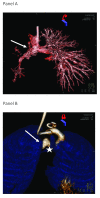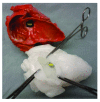Recent advances in cardiac catheterization for congenital heart disease
- PMID: 29636905
- PMCID: PMC5871969
- DOI: 10.12688/f1000research.13021.1
Recent advances in cardiac catheterization for congenital heart disease
Abstract
The field of pediatric and adult congenital cardiac catheterization has evolved rapidly in recent years. This review will focus on some of the newer endovascular technological and management strategies now being applied in the pediatric interventional laboratory. Emerging imaging techniques such as three-dimensional (3D) rotational angiography, multi-modal image fusion, 3D printing, and holographic imaging have the potential to enhance our understanding of complex congenital heart lesions for diagnostic or interventional purposes. While fluoroscopy and standard angiography remain procedural cornerstones, improved equipment design has allowed for effective radiation exposure reduction strategies. Innovations in device design and implantation techniques have enabled the application of percutaneous therapies in a wider range of patients, especially those with prohibitive surgical risk. For example, there is growing experience in transcatheter duct occlusion in symptomatic low-weight or premature infants and stent implantation into the right ventricular outflow tract or arterial duct in cyanotic neonates with duct-dependent pulmonary circulations. The application of percutaneous pulmonary valve implantation has been extended to a broader patient population with dysfunctional 'native' right ventricular outflow tracts and has spurred the development of novel techniques and devices to solve associated anatomic challenges. Finally, hybrid strategies, combining cardiosurgical and interventional approaches, have enhanced our capabilities to provide care for those with the most complex of lesions while optimizing efficacy and safety.
Keywords: angiography; cardiac catheterization; heart.
Conflict of interest statement
Competing interests: Lee Benson is a proctor for Medtronic (the manufacturer of the Melody™ valve). Sok-Leng Kang has no competing interests to declare.No competing interests were disclosed.No competing interests were disclosed.
Figures





References
Publication types
LinkOut - more resources
Full Text Sources
Other Literature Sources

